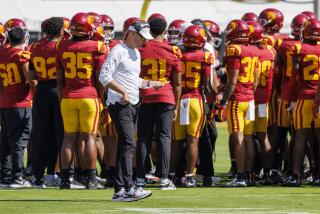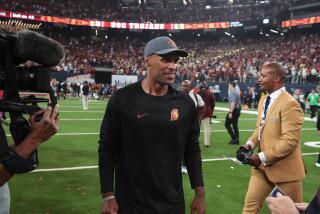No short answers for USC’s passing game
- Share via
With top NFL prospects at quarterback, receiver and tight end, and an offense-minded head coach calling the plays, it seems incongruous.
But a quarter of the way through the season, USC appears to be vertically challenged.
After ranking 15th last season, the Trojans rank 31st in passing among 120 major college teams. And many of USC’s long gains have resulted from Matt Barkley throwing horizontally toward the sideline, where receivers Marqise Lee and Robert Woods have turned short receptions into big plays.
A review of the Trojans’ first three games showed that about two-thirds of USC’s passes were thrown to receivers within 10 yards of the line of scrimmage. More than 25% were thrown to receivers behind the line of scrimmage. And only four were thrown to a receiver more than 30 yards downfield.
In last week’s upset loss at Stanford, the Trojans tried to stretch the field a bit more to exploit a Cardinal secondary thought to be a weakness. But Stanford kept consistent pressure on Barkley, sacking him four times and harassing him into two interceptions. For the first time since 2010, he did not throw a touchdown pass.
Asked this week if he would like to throw downfield more, Barkley didn’t bite.
“Coach Kiffin is doing the play calling,” he said, “and we’ll see where we go this week.”
California comes to the Coliseum on Saturday, hoping the Trojans’ passing game continues to come up short.
Barkley, who has passed for 813 yards and 10 touchdowns with three interceptions, is averaging 7.5 yards per attempt and 12.3 yards per completion. He averaged 7.9 and 11.5 last season.
Kiffin says the Trojans are fully capable of throwing long. And he adds that the offense has just missed several big plays because of opponents’ willingness to accept pass-interference penalties.
“‘The defense has decided, it appears to me sometimes, ‘Hey, we’re going to hold No. 9 and No. 2, we’ll get away with it sometimes, they’ll miss the call, and sometimes they’ll get us.’ But it will be better than giving up the deep ball as we try to run by them.”
In the opener against Hawaii, Barkley passed for 372 yards and four touchdowns. But much of the yardage came on catch-and-run plays. Lee, for example, caught a short pass and turned it into a 75-yard touchdown. Hawaii was penalized for pass interference four times.
Against Syracuse, Barkley tied a school record by passing for six touchdowns. However, he accumulated only 187 passing yards. And the one time the Trojans tried to stretch the field, Barkley underthrew Woods in the middle of the field and the Orange intercepted.
Last Saturday, a Trojans offensive line that was without senior center Khaled Holmes could not hold off an aggressive Stanford front seven.
The beating Barkley absorbed was uncharacteristic of a program that has put a premium on keeping its quarterbacks out of harm’s way. Barkley has already been sacked six times, two fewer than all of last season. USC’s success through the last decade, Kiffin said, can be traced in large part to its ability to keep its starting quarterback free of injury.
Carson Palmer did not miss a start during his Heisman Trophy-winning season in 2002. Heisman winner Matt Leinart started every game during national championship seasons in 2003 and 2004 and the Trojans’ run to the BCS title game in 2005.
USC was 2-1, losing at Oregon, with backup Mark Sanchez starting in place of injured John David Booty in 2007. The Trojans lost at Washington with Aaron Corp starting in place of Barkley in 2009 and to Notre Dame with Mitch Mustain starting in place of Barkley in 2010.
“That is why you do what we do in the first two games,” Kiffin said of a having Barkley get rid of the ball quickly. “And people say, ‘Well, boy, it’s not really downfield that much.’ But it’s very efficient and you’re making first downs and you’re not getting your quarterback hit.
“Because when you get your quarterback hit, all of a sudden those numbers start coming down and he starts doing things that you’re not used to seeing. And that’s exactly what happened,” against Stanford.
Barkley emerged largely unscathed and insists his arm is fine. But an NFL scout said that for a quarterback who does so many other things well, arm strength is the one area of concern for Barkley in terms of his pro potential.
“He kind of lets balls float,” said the scout, who requested anonymity. “He’ll throw a nice ball and then he’ll throw one that hangs in the middle of the field. There are some inconsistencies with his deep ball.”
That problem could be mitigated if the Trojans develop a consistent running attack.
USC has rushed for only 365 yards this season, a season-low 26 against Stanford.
Many of USC’s long pass plays through the years came after play-action fakes. “Getting the safeties to come down sets up the play-action and the deep passes,” Woods said.
So Kiffin is looking for the Trojans’ rushing attack to improve. “When we can’t run the ball, the system doesn’t work,” he said. “We don’t drop back very much — we’re a play-action team so we can protect our quarterback.
“When the runs aren’t working, they don’t bite. And then guys aren’t getting open, guys are all over them and you have to make tougher throws.”
Lee is not concerned.
His deep thought: keep throwing.
“As long as you capitalize on the little things,” he said, “they become big things eventually.”
twitter.com/latimesklein
Staff writer Sam Farmer contributed to this report.
More to Read
Fight on! Are you a true Trojans fan?
Get our Times of Troy newsletter for USC insights, news and much more.
You may occasionally receive promotional content from the Los Angeles Times.







